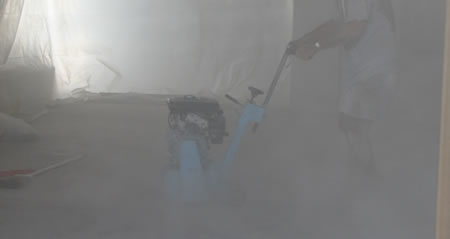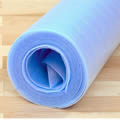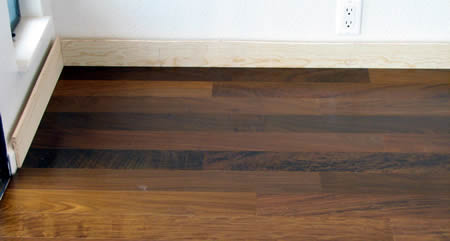I’m happy to say that our hardwood floors are fully installed! The bulk of the credit has to go to my father-in-law, who while he has never installed any hardwood flooring before, provided the peripheral knowledge and common sense that is need in doing such home projects. My wife and I basically served as unskilled day laborers. 🙂 If you’re looking to install your own wood flooring, you might want check out my previous post on picking out what type of flooring to buy and how to install it. We had a concrete subfloor, and we chose to float an engineered hardwood flooring over it. This might not be the best choice for everyone.
Prepping the Concrete Floors
The first part of installation is to make sure you have a relatively level subfloor. A rough rule of thumb is that you want to see no gaps thicker than 1/8″ of space if you lay down a 5 ft-long straight piece of wood like a 2×4 flat on the ground. (Or 1/4″ every 10 feet.) This part is important in order to avoid squeaks and squishy spots, and lazy installers (both hired and DIY) will simply lay over anything remotely flat. If you do demand proper prep and your floor isn’t flat, this can add to installation costs when contracting it out (and therefore savings if you do it yourself).
We were hoping preparation would just mean scraping excess carpet glue or drywall mud off of the subfloor. But we found that we actually had a good-sized area which was not flat at all. We tried using a hand grinder at first, but in the end we rented what they called a concrete planer in order to grind it down flat. It is a beast and we ended up with over 30 pounds of concrete dust everywhere. We had put up tarps, but it still got everywhere. This would have been horrible if we were already living in the house, luckily we weren’t. I think it cost about $250 to rent for a day.

Laying Underlayment
 Next step was to lay down a thin blue foam underlayment on top of the concrete. The underlayment is designed as a moisture barrier between the wood and the concrete, reduces sound, and also adjust for the remaining minor irregularities in the subfloor. We just taped it down with duct tape. Some newer flooring products actually have this already on the bottom of the flooring.
Next step was to lay down a thin blue foam underlayment on top of the concrete. The underlayment is designed as a moisture barrier between the wood and the concrete, reduces sound, and also adjust for the remaining minor irregularities in the subfloor. We just taped it down with duct tape. Some newer flooring products actually have this already on the bottom of the flooring.
Connecting The Pieces Together
Our flooring was tongue-in-groove, with glue applied in the grooves. Some other types allow you to simply click together, but we found this was mainly for laminate flooring. We put in spacers at the walls, as the floating floor has to be allowed to contract and expand with the seasons. Trim is added later to hide the gaps. You’ll need some sort of table or chop saw to cut the pieces to fit when you reach the other wall and at corners.

Trim and Moldings
Finally to make everything look nice, you’ll need to install moldings at walls, doorways, and transitions to other floor types. You’ll also have to cover up all the nail holes with putty so they don’t show. This all takes a lot of patience to do well, which can be tough when you’re tired of installing wood and you just want to be done already.
Final Verdict and Parting Advice…
We are very happy with the final product. I think anybody who is reasonably comfortable with tools and has the proper patience can perform this activity, the only question is if you actually want to. Either using up a week of vacation or giving up all your weekends for a month isn’t always fun, although I did learn a lot and lost some weight in the process. Oh, and there’s always the several thousand dollars in installation costs that we saved.
We do have some squishiness in the floor when walking on it, but it is not very prominent and we don’t mind. Of course it wouldn’t be there at all if we decided to do a glue-down floor, but I think it was still worth it to float given the time saved and the ability to easily fix any mistakes as we went.
As for parting advice… buy good knee pads! My father-in-law is old school and tough, and didn’t ever wear knee pads the entire time, so I figured I didn’t need them either. On the second day of installation, I started seeing red spots all over the underlayment. Did someone spill ketchup? Nope, my knees had blistered and were bleeding all over the place… Good knee pads are worth every penny. In general, it is worth it to buy the proper, quality tools for the job. If you’re doing this is as a weekend warrior type of activity, it takes a lot of determination to finish everything, so there’s no need to make things harder on yourself.
 The Best Credit Card Bonus Offers – 2025
The Best Credit Card Bonus Offers – 2025 Big List of Free Stocks from Brokerage Apps
Big List of Free Stocks from Brokerage Apps Best Interest Rates on Cash - 2025
Best Interest Rates on Cash - 2025 Free Credit Scores x 3 + Free Credit Monitoring
Free Credit Scores x 3 + Free Credit Monitoring Best No Fee 0% APR Balance Transfer Offers
Best No Fee 0% APR Balance Transfer Offers Little-Known Cellular Data Plans That Can Save Big Money
Little-Known Cellular Data Plans That Can Save Big Money How To Haggle Your Cable or Direct TV Bill
How To Haggle Your Cable or Direct TV Bill Big List of Free Consumer Data Reports (Credit, Rent, Work)
Big List of Free Consumer Data Reports (Credit, Rent, Work)
I’m not sure whether the picture in the post is from your project, but I recommend that you paint the base molding before you nail it to the wall. It’s a lot easier than trying to paint it after the fact. Then use white caulk at the top of the molding and white wood filler for the nail holes and touch up with paint.
Jon
I applaud you for taking on such a large project as a DIY! Sounds like you’re happy with the outcome.
I have a question for you though. Looking back, would you say that you’re personal time was worth the money you saved? Or, would you say that you’d rather pay more to have your time back to do other things and have the knowledge that the work is guaranteed for some amount of time should something go awry?
My largest concern with doing flooring myself is that something will go wrong after the fact, and the expense, time and effort to repair it will far exceed just paying someone qualified in the first place (who probably guarantees the work for a period of time). I feel the same way with plumbing and electrical, as one small mistake can ruin an entire house. Everything else, I’ll try.
I had my hard wood floors professionally installed on top of concrete and glued to a liner. One other tool they have at their disposal is a special power saw that will trim door jams at the floor level so that the flooring can be laid directly under the jam. Makes for a nice neat floor. They also have colored putty to fill in areas where one needs to fill 1/8 to 1/4 inch gaps near doors, walls, etc. where you don’t have trim to cover.
“In general, it is worth it to buy the proper, quality tools for the job.”
This is one of the greatest DIY truths ever told. That being said, I have helped my father craft our own tools for things we didn’t have in media res, but the right tool usually pays for itself in headaches and also offers you the opportunity to use it again, whether for yourself or in helping someone else.
Sometimes the tools are a scam- fancy flanges or angles- but you cannot underestimate the value of having the right tool when it really does matter.
I definitely hear what you’re saying about shoddy work. I think it’s very cool that you guys took on such a big project on your own.
BTW, not sure if the finished picture is your floor, but I love the color!
Did you happen to use the glue they recommend for it in water prone areas? I used it for mine and I’ve had no problems no matter how much water go onto the floor.
There’s no such thing as a perfectly done home improvement. I figure if I do it myself at least I have the satisfaction of the accomplishment. I know exactly where I screwed up, but I can live with that. If I pay someone else to do it, I’ll eventually figure out what they screwed up and then I’ll feel either ripped off or like I screwed up hiring them in the first place.
After paying off our house in January (8 years early), we are finally ready to do all the upgrades we’ve been waiting to do. I want to do hardwood floors really bad, but there are things to consider. My husband (who is a mailman) and I both have foot problems, and even with area rugs, I’m afraid it would be hard on us. Are floating floors softer? Is there any hardwood floor that would be comfortable for sore feet?
We just ordered beautiful new leather furniture, and the hardwoods would look so good, but I have so many questions about the comfort. I had hardwoods in a previous house, and they were certainly easier to take care of than carpet.
But first things first. We are having our house completely re-plumbed. That’s not something I want to tackle myself, because I’m getting a lifetime warranty on it.
Back to the subject, what are the advantages with a floating floor versus one that’s attached?
Randy, do what I did tonight. I’m having my house re-plumbed, and the plumber found faulty drain systems. I called my previous plumber (who happens to be an old friend, too), and told him there were a couple of P-traps missing. He’s coming tomorrow to fix them for free. We all need to challenge those people who do the faulty work, and insist they make it right. Nobody wants to be reported to the BBB…even an old friend!
I did use the special $8 per bottle of glue for in between the floor boards. Supposedly the stuff is significantly better than the cheaper glue from Home Depot. I am not smart enough to know if this is true, but I figured I’d go with the manufacturer recommended stuff.
Yeah. It seems to be pretty good to me, so I don’t feel bad about using it even if it was a couple dollars more.
caulk over baseboards… god no – it makes such a mess for the next person. i just tore up old carpet and put down tile – they had caulk on the walls – made my life miserable for an afternoon fixing it.
another tip – find a buddy and share labor – a friend and I have torn a kitchen and bathroom to the studs, removed 2 walls (to make both rooms bigger), hung drywall, re-laid carpet, and put in a tile floor in the past month… tile floor #2 goes in on saturday. two people who know what they are doing can move much more quickly than one – you will both benefit.
Great project. We did a similar project using laminate flooring and also ended up with the squeaks and creaks from just using the poly foam underlay. When we came to the second room which we decided to use real wood, it was laid down on a base of plywood so the floor is now solid with no speaks and creaks (It cost a bit more but was worth it). Either way its a great saving on money and very satisfying to see the results after the task is complete.
Instead of grinding off high spots on the concrete to make it flatter, you could have used a levelling product (kind of a real soupy cement mix) that you pour over the concrete to bring up the low spots. (Posted the odd chance that this information would be useful someday to someone reading it!)
Excellent job – if you’re looking for some extra income we’re hiring just now 🙂
We have bought engineered wood flooring for our house and were just told today that we shouldn’t float it because the room is so big. I have never heard of this before. The room is 25′ x 25′. Do you know if this is true?
Sorry to come late to the party, but I’m looking at this exact project myself! I want to learn from your example, so tell me, was the concrete planner the only option? Would this stuff have worked?
http://www.edisoncoatings.com/html/Self_Leveling_Concrete_Floor_T/self_leveling_concrete_floor_t.htm
Any one use the self leveling before? Anyway, thanks for the post! I appreciate knowing that the job is doable.
We also used some self-leveling cement. It’s really only for small imperfections, not for significant slopes or bumps. Works, but a bit messy. Good luck!
Hi, I was wondering if your floor makes any noise? Thanks.
I just had engineered wood floors put. The guys left while I was at work. I have inspected the work and it seems fine except for 4 spots. I can see where they cut a piece of wood an a tiny piece broke off like it was a rough cut. Its small. About the size of 1/4 a pencil eraser. However, the color under the wood is different from the wood color and I picked it up right away. Should I get them back? Do I just wood putty the spots? Will they get bigger in time?
Can anyone tell me where I can get the blue foam underlayer in North America? I need a thin blue foam liek the one included in the picture above, where can I find it?
Thanks for your helo!
Responding to an old post, I know…. but just in case someone else, like I did, is reading this years later…
We just put down a click-loc engineered hardwood floor. Totally glueless. It went in very easily – the only real work was cutting the bottoms of the door jambs (we found that a handsaw worked perfectly well, when a scrap piece of flooring (actually, a sample from the store) was used as a guide) and cutting end pieces to fit the dimensions of the room. As we did this 3.5 years later than you, I think some of the technology may have improved, too. Engineered is actually superior to solid hardwood in a number of ways, but what impressed me was how perfectly-engineered each plank way. There was very little waste, because there were no flawed boards. Our house is less than 10 years old and has very sturdy, level subfloors, so we don’t find that we have a “hollow” sound when walking on the floor. I was thrilled with the ease of installation… it literally is a “snap,” and when finished, you can’t tell the difference between nailed tongue and groove boards, and click-loc boards.
We bought a product with a “handscraped” finish. It’s really machine-planed, so the “handscraping” pattern is very regular, which is the only “fake-looking” thing about this wood. The combination of a totally floating floor, the handscraping, and the very smooth finish makes this about as easy on the feet as any wood floor could be. There is no really noticeable give, but it does give just slightly, and with the foam underneath, has some cushioning. The handscraping actually feels good to the feet.
Betsy,
What brand of floor did you use. I am in the process of building a home and had to give up on paying the builder to upgrade the floor because of the cost. So now I am looking for exactly what you are talking about. Engineered handscraped. And click-loc would be awesome. I am in the Houston, TX area. We have lumber liquidators and floor & decor stores nearby.
thanks!
harmonics and clik-lok are available at COSTCO